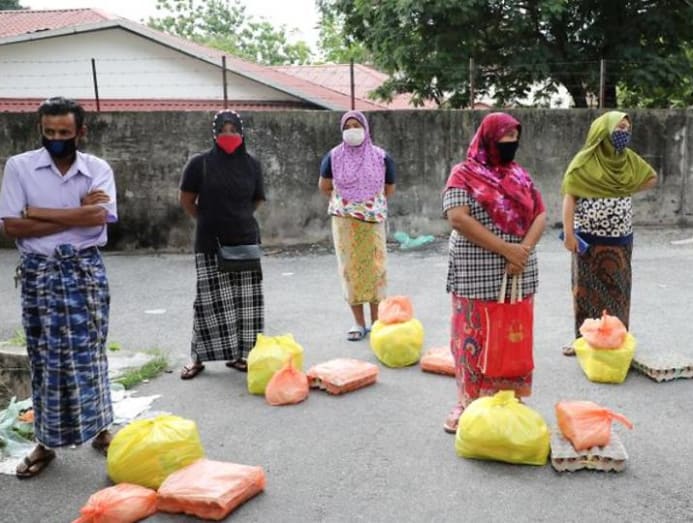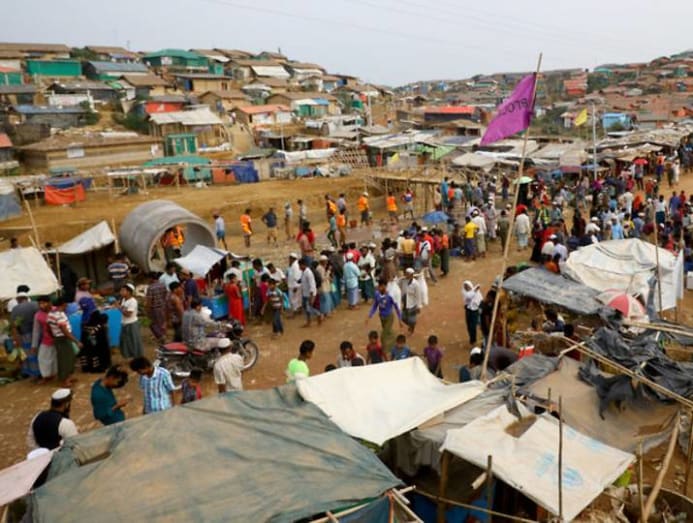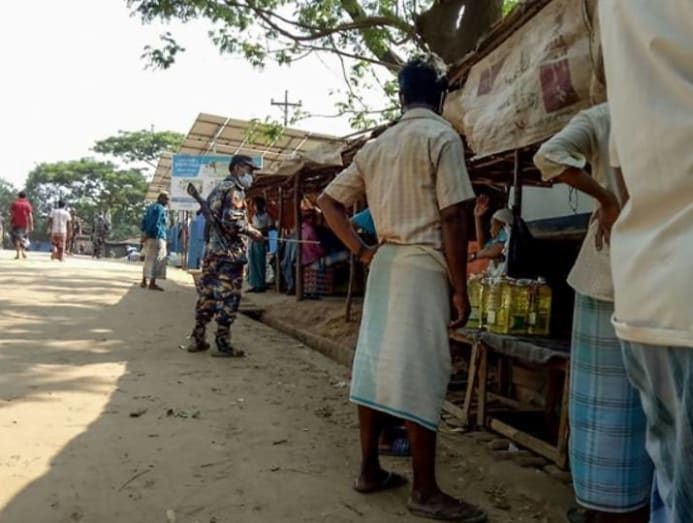Commentary: The danger of disease in Cox's Bazar, home to the world’s largest refugee camp
MELBOURNE: The Bangladesh government made the conclusion earlier this month to identify the southern district of Cox's Bazar in lockdown as COVID-19 cases in Bangladesh increased.
Cox'south Bazar hosts the world's largest refugee camp, housing almost a million Rohingya since tardily 2022 when around 700,000 fled violence in Myanmar, joining those previously displaced by fighting.
While there is yet to be a positive case of coronavirus identified in the refugee camps, the first case was recorded in the city of Cox'south Bazar on Mar 24.
Entry and exit from the area – other than emergency food supplies and medical support – has been prohibited in an effort to finish the spread of the virus.
A recent written report for the Centre for Humanitarian Health at John Hopkins University has nevertheless suggested that a large-scale outbreak of COVID-19 in the camps is very likely and would lead to thousands of deaths.
READ: Commentary: Has Myanmar been in deprival over COVID-19 outbreak all this while?
READ: Commentary: Myanmar's COVID-19 cruise-send moment as thousands of migrant workers flock back dwelling
REFUGEES UNIQUELY VULNERABLE
Communities displaced by conflict are uniquely vulnerable to pandemics. In fact, displaced populations are peculiarly vulnerable to infectious diseases, and are more probable to die from infectious diseases than anything else.
This is considering their immune systems are ofttimes depleted, often having had limited access to food, potable water, and healthcare, and living in overcrowded and unsanitary camps.
Almost immediately later the influx of Rohingya refugees into Cox's Bazar in tardily 2017, the World Health Organization detected a rapid and ongoing spread of diphtheria in the camps.
Diphtheria, similar COVID-nineteen, is transmitted through respiratory droplets, and spreads quickly in overcrowded, unsanitary weather with compromised immune systems.

In 2018, the Inter Sector Coordination Group (ISCG) further warned that the presence of cholera and acute watery diarrhea in Bangladesh, combined with overcrowding, lack of access to safe water and high rates of malnutrition in the camps, could result in an outbreak having "the potential to kill thousands".
The pre-existing prevalence of acute respiratory infection, with around 175,000 cases since start of 2020, is a strong indicator that COVID-xix would spread easily in the camps.
While diphtheria has a vaccine, and cholera a treatment plan, COVID-19 so far has neither. In the absence of a vaccine or effective treatment, social distancing, self-isolation, and proficient hygiene practices take proven to be the most effective ways of staying safe during the COVID-19 pandemic.
This fact has exposed socio-economical inequalities betwixt those who are capable of these strategies, and those who are not.
READ: Commentary: Restrictions on movements in some Southeast Asian countries to fight COVID-xix take been patchy, even scary
READ: Commentary: COVID-19 volition deepen global inequality
SOCIAL DISTANCING A 'LUXURY'
For communities that are displaced by conflict, social distancing, cocky-isolation and access to lather and water are immediate challenges. For many of these people, the ability to isolate themselves from others is, as described past Medecins Sans Frontieres, "a luxury".
For the Rohingya who alive in the 34 makeshift refugee camps in Cox's Bazar, social distancing is not possible.
Most live in cramped shelters covered with tarpaulin, and access to nutrient and potable water is express; information technology generally requires daily walks and waiting in queues.
People too need to walk to and queue for overburdened and overcrowded hygiene facilities, including toilets – and they have limited access to soap.

The camps themselves are severely overcrowded. 40,000 Rohingya reside in a unmarried square kilometre.
Overcrowding makes basic services difficult to provide, and the blitz to provide water facilities and latrines, after the influx of more refugees in 2017, increased the risk of water contamination.
LIMITED Access TO INFORMATION AND SERVICES
Rohingya in these camps also accept somewhat limited admission to health intendance information and services, with health infrastructure already overstretched and under-resourced, and health services not enjoying the full confidence and trust of the Rohingya residents.
This undermines their ability to protect themselves and compromises whatever endeavor to place, monitor and comprise outbreaks of contagious diseases.
READ: Commentary: Republic of india's handling of COVID-xix a homo-made tragedy
READ: Commentary: How well has India been treatment the COVID-19 pandemic?
Limited admission to healthcare information was compounded recently past the government ban on mobile-phone and internet usage (Rohingya in the camps are not able to legally buy SIM cards and internet coverage in the camps has been restricted since September 2019).
This has generated misinformation and ignorance nigh COVID-19 and led to 26 international humanitarian agencies calling on both the Bangladesh and Myanmar Governments on Apr 16 to restore telecommunications in lodge to support "humanitarian efforts to save lives".
This ban has also separated Rohingya from back up networks in Myanmar and elsewhere, which is so important at this fourth dimension.
Misinformation is further resulting in people who feel unwell not disclosing this information because of frightening rumours virtually what regime exercise to people showing symptoms of COVID-19.
In addition to the impact this might accept upon the spread of the disease, information technology further increases fright, insecurity and stress among the Rohingya.
READ: Commentary: Forwarding a WhatsApp message on COVID-xix news? How to make certain you don't spread misinformation

Telecommunication is also essential to comport out humanitarian work, particularly now as international actors piece of work remotely (to avoid bringing the virus into the camps) and rely on people in situ.
While some international organisations have connected and expanded their activities in the camps to best prepare for an outbreak of COVID-19, all relief work other than essential activities was halted in late March.
Protection services have fatigued down, including child protection and psychosocial support, leading to likely increases in insecurity and violence, especially as stress and anxiety increase in the camps. Child-friendly spaces have been airtight and a long-awaited education program put on hold.
Children, and peculiarly girls who are often bars to their shelters, are thus unable to access what may be their only rubber spaces and support mechanisms at a time when they are most needed – compromising their current and future well-being.
READ: Commentary: Philippines' COVID-xix fight depends on the exploitation of healthcare workers
READ: Commentary: Isolated with your abuser? Why family violence seems to exist on the rise during COVID-19 outbreak
And then far, feel has shown that responding to the coronavirus pandemic requires early action, well-resourced and organised wellness care, socially disciplined and well-informed populations with the capacity and resilience to respond, and space and fourth dimension.
These were already in short supply in refugee communities. Equally Bangladesh enters its monsoon season in coming months, major challenges are ahead.
BOOKMARK THIS: Our comprehensive coverage of the novel coronavirus and its developments
Download our app or subscribe to our Telegram channel for the latest updates on the coronavirus outbreak: https://cna.asia/telegram
Eleanor Gordon is Senior Lecturer in Politics and International Relations at Monash Academy. Associate Professor Katrina Lee-Koo is Reader in International Relations at Monash University and Deputy Director of Monash Academy's Gender, Peace and Security Research Centre. This commentary showtime appeared on The Interpreter.
thornhillactem1984.blogspot.com
Source: https://cnalifestyle.channelnewsasia.com/commentary/commentary-danger-disease-coxs-bazar-home-worlds-largest-refugee-camp-298381
0 Response to "Commentary: The danger of disease in Cox's Bazar, home to the world’s largest refugee camp"
Post a Comment